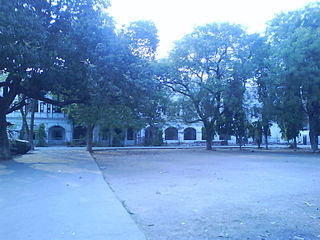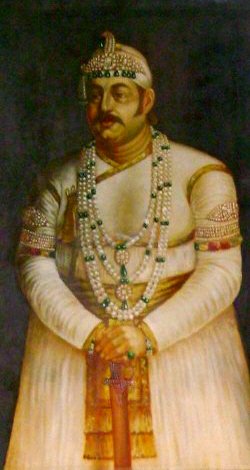Related Research Articles

Hyderabad State was an independent monarchy/princely state located in the south-central Deccan region of Indian Subcontinent with its capital at the city of Hyderabad. It is now divided into the present-day state of Telangana, the Kalyana-Karnataka region of Karnataka, and the Marathwada region of Maharashtra in India.

Mir Qamar-ud-din Khan Siddiqi also known as Chin Qilich Qamaruddin Khan, Nizam-ul-Mulk, Asaf Jah and Nizam I, was the first Nizam of Hyderabad. He was married to the daughter of a Syed nobleman of Gulbarga. He began his career as a favourite of the Mughal emperor Aurangzeb, who made him a general. Following the death of Aurangzeb in 1707, Asaf Jah refused to favour any one of Aurangzeb's warring sons and as such remained neutral. When Aurangzeb's third son Bahadur Shah ultimately emerged victorious, Asaf Jah was rotated as governor of multiple Mughal provinces until 1714, when he was created Viceroy of the Deccan with authority over six Mughal provinces in southern India from 1714 to 1719. From 1719 onwards he was involved in combating the intrigues of the Sayyid Brothers. From 1720 to 1722 he helped the new Mughal emperor Muhammad Shah eliminate the Sayyed brothers and was rewarded by being elevated to the grand viziership from 1722 to 1724.

Mirza Nasir-ud-Din Muḥammad Shah was the thirteenth Mughal emperor from 1719 to 1748. He was son of Khujista Akhtar, the fourth son of Bahadur Shah I. After being chosen by the Sayyid Brothers of Barha, he ascended the throne at the young age of 16, under their strict supervision.

Nizam of Hyderabad was the title of the ruler of Hyderabad State. Nizam is a shortened form of Niẓām ul-Mulk, which means Administrator of the Realm, and was the title bestowed upon Asaf Jah I when he was appointed Viceroy of the Deccan by the Mughal Emperor Farrukhsiyar. In addition to being the Mughal Viceroy (Naib) of the Deccan, Asaf Jah I was also the premier courtier of the Mughal Empire until 1724, when he established the independent monarchy of Hyderabad and adopted the title "Nizam of Hyderabad".

Secunderabad, also spelled as Sikandarabad, is a twin city of Hyderabad and one of the six zones of the Greater Hyderabad Municipal Corporation (GHMC) in the Indian state of Telangana. It is the headquarters of the South Central Railway zone. Named after the Mir Akbar Ali Khan Sikander Jah, Asaf Jah III, Nizam of the Asaf Jahi dynasty, Secunderabad was established in 1806 as a British cantonment. Although both the cities are together referred to as the twin cities, Hyderabad and Secunderabad have different histories and cultures, with Secunderabad having developed directly under British rule until 1948, and Hyderabad as the capital of the Nizams' princely state of Hyderabad. Since 1956, the city has housed the Rashtrapati Nilayam, the winter office of the president of India.

Asaf Jah VI, also known as Sir Mir Mahboob Ali Khan Siddiqi Bayafandi, was the ninth Nizam of Hyderabad. He ruled Hyderabad State, one of the princely states of India, between 1869 and 1911.

Mir Osman Ali Khan, Asaf Jah VII was the last Nizam (ruler) of the Princely State of Kingdom of Hyderabad, the largest state in British India. He ascended the throne on 29 August 1911, at the age of 25 and ruled the Kingdom of Hyderabad between 1911 and 1948, until India annexed it. He was styled as His Exalted Highness (H.E.H) the Nizam of Hyderabad, and was widely considered one of the world's wealthiest people of all time. With some estimates placing his wealth at 2% of U.S. GDP, his portrait was on the cover of Time magazine in 1937. As a semi-autonomous monarch, he had his mint, printing his currency, the Hyderabadi rupee, and had a private treasury that was said to contain £100 million in gold and silver bullion, and a further £400 million of jewels. The major source of his wealth was the Golconda mines, the only supplier of diamonds in the world at that time. Among them was the Jacob Diamond, valued at some £50 million, and used by the Nizam as a paperweight.

Purani Haveli, also known as Masarrat Mahal palace, is a palace located in Hyderabad, Telangana, India. It was the official residence of the Nizam. It was also known as Haveli Khadeem, which means old mansion, was constructed for Sikander Jah, Asaf Jah III (1803–1829) by his father Ali Khan Bahadur, Asaf Jah II.

Sikander Jah, Asaf Jah III, was the 6th Nizam of Hyderabad, India from 1803 to 1829. He was born in Chowmahalla Palace in the Khilwath, the second son of Asaf Jah II and Tahniat un-nisa Begum.

Afzal ad-Dawlah, Asaf Jah VMir Tahniyat Ali Khan Siddiqi was the eighth Nizam of Hyderabad, India, from 1857 to 1869.

Sir Mir Turab Ali Khan, Salar Jung I,, known simply as Salar Jung I, was an Indian nobleman who served as Prime Minister of Hyderabad State between 1853 until his death in 1883. He also served as regent for the sixth Nizam, Asaf Jah VI between 1869 and 1883.

The Asaf Jahi was a Muslim dynasty that ruled the Hyderabad State. The family came to India in the late 17th century and became employees of the Mughal Empire. They were great patrons of Persian culture, language, and literature, and the family found ready patronage.
Sikandar is the Persian rendition of the name Alexander. When the Greek king Alexander the Great conquered Persia, the Persians called him Sikandar lidi, meaning "defender" or "warrior". It is a variant of Iskandar.

Nizam's Guaranteed State Railway (NGSR) was a railway company operating in India from 1879 to 1950. It was owned by the Nizams of Hyderabad State, and its full name was His Exalted Highness, The Nizam's Guaranteed State Railway. The company began with a line built privately by the HEH, the Nizam, which was owned and operated by the company under a guarantee from the Hyderabad State, much to the dismay of the British authorities. Capital for the line was raised by issuing redeemable mortgage debentures. The Nizam's railway was eventually consolidated with the Hyderabad-Godavari Valley Railway (HGVR). In 1951, both the NGSR and the HGVR were nationalised and merged into Indian Railways.

Mu'inud-Daulah, Mushirul-Mulk, Azamul-Umara, Arastu Jah, a man of Persian descent, was the Diwan or the Prime Minister of Hyderabad during the reign of Nizam Ali Khan from 1778 until his death in 1804.

Saifabad Palace was a palace in the city of Hyderabad, Telangana, India. Built in 1885 by Mahboob Ali Khan, the sixth Nizam of Hyderabad, it served as the seat of government for various Indian states until its demolition in 2020.

Pahalwan also pronounced as Pehelwan, Pahelwan means Wrestler in English. In Hyderabad India, the word Pahalwan is generally called and related with two types of People.
Hyderabad was the capital of the Indian states of Telangana. It is a historic city noted for its many monuments, temples, mosques and bazaars. A multitude of influences has shaped the character of the city in the last 400 years.

The history of Telangana, located on the high Deccan Plateau, includes its being ruled by the Satavahana Dynasty, the Kakatiya Dynasty (1083–1323), the Musunuri Nayaks (1326–1356), the Delhi Sultanate, the Bahmani Sultanate (1347–1512), Golconda Sultanate (1512–1687) and Asaf Jahi dynasty (1724–1950).
References
- ↑ "Coordinates". latlong.net. Archived from the original on 7 August 2017. Retrieved 9 January 2017.
- 1 2 3 4 5 "Profile". Official website. Retrieved 9 January 2017.
- ↑ "Coins". Reserve Bank of India. Retrieved 9 January 2017.
- 1 2 3 4 "History". Official website. Retrieved 9 January 2017.
- ↑ "Corporatization". Official website. Archived from the original on 5 October 2018. Retrieved 9 January 2017.
- ↑ "Organization Structure". Official website. Retrieved 9 January 2017.
- ↑ "Mint mark". numista. Retrieved 9 January 2017.